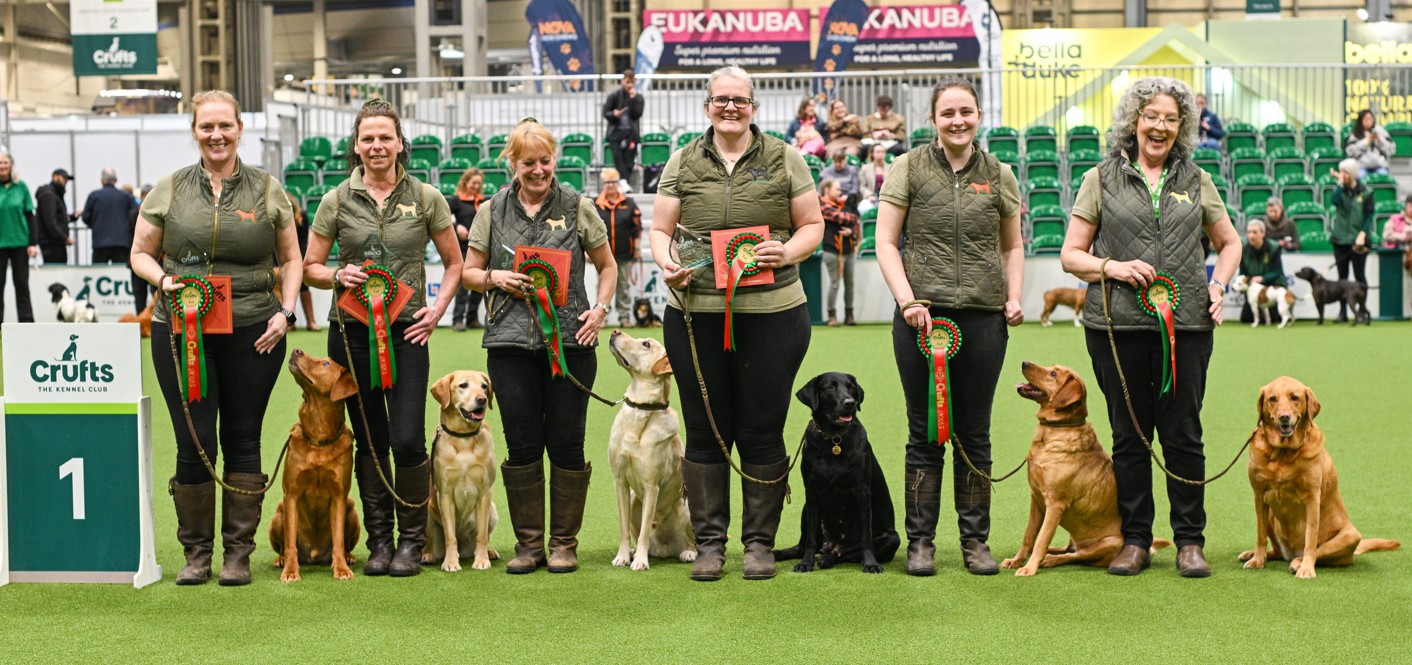
Obreedience, introduced to Crufts in 2014, invites various breeds to ‘have a go’ in competitive obedience in a more fun, relaxed environment. Teams of four handlers and four dogs of the same breed, come together to showcase their talents through enjoyable exercises for all ages and abilities. Teams compete in group heelwork and four set exercises.
Each obreedience team must comprise of four handlers and four dogs of the same breed who take part in two rounds of competition, including a round of heelwork performed together as a group and then four set exercises including a retrieve, a 'send to bed', commanding the dog to stop, and a scent exercise.
Results from heats for Crufts 2026
Results from heats for Crufts 2026
| Team name | Breed | Breed Group |
United Spaniel Association 19 Jan 2025 |
Sheffield GSD Society 13 Apr 2025 |
Best Paws Forward 26 Apr 2025 |
Nuneaton DTC 10 May |
Loughborough DTC 17 May |
Durham County Canine Association 13 July |
Winchester City DTC 13 July |
Culverstone DTC 20 July |
Hatchford Brook 3 August |
Solihull 5 August |
Worcester DTC 24 August |
Sheffield GSD 19 October |
Total |
|---|---|---|---|---|---|---|---|---|---|---|---|---|---|---|---|
| Super Staffords |
Stafforshire Bull Terrier
|
Terrier |
5
|
10 | 10 | 10 | 10 | 9 | 10 | 7 | 9 | 9 | 10 | 99 | |
| The Cool Cockers | Cocker Spaniel | Gundog | 9 | 3 | 7 | 7 | 8 | 7 | 9 | 6 | 10 | 6 | 72 | ||
| MRU | Manchester Terrier | Terrier | 10 | 9 | 8 | 9 | 9 | 10 | 7 | 69 | |||||
| The Labrapaws | Labrador | Gundog | 6 | 8 | 9 | 6 | 7 | 4 | 10 | 9 | 59 | ||||
| The Russellers | Jack Russell Terrier | Terrier | 2 | 5 | 3 | 8 | 8 | 5 | 8 | 8 | 8 | 55 | |||
| The Wagtails | Cavalier King Charles Spaniel | Toy | 8 | 6 | 10 | 9 | 6 | 4 | 43 | ||||||
| Diamonds in the Rough | Rough Collie | Pastoral | 3 | 7 | 4 | 8 | 5 | 7 | 6 | 40 | |||||
| Dachtastic | Miniature Longhaired Dachshund | Hound | 7 | 6 | 5 | 5 | 3 | 26 | |||||||
| Stafford Stars | Stafforshire Bull Terrier | Terrier | 4 | 2 | 1 | 4 | 5 | 5 | 21 | ||||||
| Spring It On | English Springer Spaniel | Gundog | 4 | 2 | 6 | 4 | 16 | ||||||||
| Barkees | Keeshond | Utility | 1 | 9 | 4 | 14 | |||||||||
| The Shetlanders | Shetland Sheepdogs | Pastoral | 10 | 10 | |||||||||||
| Supernovas | Nova Scotia Duck Tolling Retriever | Gundog | 8 | 8 | |||||||||||
Obreedience Rules for Crufts 2025
Introduction
The aim of Obreedience is to encourage a wider variety of different breeds to take part in a competition, which includes some of the exercises generally associated with Obedience. Obreedience is a team event and highlights the abilities of different breeds in a relaxed and fun competition.
Obreedience heats may be held with Kennel Club permission as a‘Special Class’ at Kennel club licensed shows/trials/competitions, or held as standalone heats.
The regulations that the license is granted under, will apply as will the general Kennel Club Rules and Regulations and Code of Conduct.
There is no limit to the number of members that make up a particular team but each heat requires four handlers and four dogs of the same breed which take part in two rounds of competition. The 1st is a team heelwork round and the 2nd, a round of 4 individual exercises, each one completed by a different dog and handler.
Brief Descriptions of Exercises
(Please see ‘Information for judges for a more in depth description of the requirements of each exercise)
Heelwork
Is a stewarded team exercise where all dogs start and end sitting at heel beside the handlers left leg. Dogs and handlers should remain synchronised and in line, throughout the chosen pattern of turns, weave and halts, without the need for the lead to be tight. There are 3 heelwork patterns for the judge to choose from, which may be found further down this page (Test A, Test B and Test C)
Individual exercises will all start and end on the steward’s direction.
Send to bed
The dog should go to its bed and settle there, on the command of it’s handler. The dog is shown where the bed is positioned prior to the handler returning with him/her to the start point of the exercise. The dog should remain on the bed until the handler has replaced the lead, signifying the end of exercise.
Retrieve
The dog should retrieve an article, thrown by the handler, and should return with it to sit in front of the handler. The dog should continue holding the article until the handler takes it, before sending the dog on the steward’s command, to sit beside their left leg.
Stop the Dog and Play
The dog must be able to remain in a settled position, whilst the handler moves away to a designated spot. The handler is asked to recall the dog, but must then stop it within a marked area. The dog should remain in position until the handler returns, clips the lead on and then plays with the dog, until the steward signifies the end of exercise.
Scent
The dog’s article is placed in position, in a straight line made up of 5 other articles, with the dog’s view of them obscured. The dog is then sent to find its own article, ignoring the other 5. The dog is likely to use both sight and scent to detect the correct article, and having done so, should return with it, to sit in front of the handler. The handler must take the article, before sending the dog to sit beside their left leg, when asked to do so by the steward.
Heats
All heats must take place at events licensed by The Kennel Club and the class name in the schedule should replicate exactly the name of the competition as stated in these rules.
There will be a maximum of 15 heats per year, no 2 heats will be scheduled for the same day and distance will be considered when granting permission to run 2 heats on consecutive days.
Dogs entered must be registered with The Kennel Club on the Breed Register, or on the Activity Register as a Kennel Club recognised pedigree breed (crossbreeds are not eligible to compete in Obreedience).
To qualify for the final, points will be accumulated throughout the year at designated heats.
The team name should remain the same throughout all the heats. Substitution of dogs or handlers cannot be made after the closing date for that heat. A dog may only compete in one team per heat.
If at the conclusion of the heats there is an equality of points, the team which has achieved the highest place will take preference when deciding the teams final overall place and the qualification for invitation to the final at Crufts.
The heats will be scheduled as a special class for pedigree dogs. There will be separate heats with the top 10 teams at each heat eligible to receive points.
Judge information
General guidelines
To judge an Obreedience heat you should be a qualified and experienced judge in either Obedience or Rally, preferably one who has experience of judging a variety of breeds.
Each judge will have their own view of the perfect performance and will need to be able to differentiate between a good and an excellent, performance in order to allocate team places appropriately. Minor marks may be deducted from the perfect score for example, for things like loss of formation in heelwork, for tight leads, or in any of the exercises for sits that are not in unison, or that are too far away from the handler or not straight, if the judge thinks that commands given to cue a behaviour are excessive, if retrieve or scent articles are not picked up cleanly or are chewed or dropped or if the dog can’t remain in place in the ‘waits’, the ‘stop’ or the bed. More major faults would include soiling the ring, deviation en route to retrieve, scent or the bed or not returning directly to the handler when off lead and recalled.
There will be two rounds of the competition: Round 1 - heelwork, followed by Round 2 - four set exercises. All the heelwork rounds should be completed before the set exercises. Ring size and/or judge’s preference will determine whether all 4 individual exercises can be set up to run concurrently in Round 2, or whether Round 2 will consist of ‘Send to bed’, ‘retrieve’ and ‘stop the dog and play’, and a 3rd round then for ‘scent’.
Please ensure team members are ready to compete when their running order is due. Judging will not be delayed if team members are absent. There will be a running order for all teams taking part. Flexibility on running order and a discussion with the Chief Steward, fellow judges and Obreedience team captains is advised, if there is a potential clash of competitions. Obedience and Rally running orders will take precedence.
Whilst handlers may use verbal or physical encouragement throughout the test, except within the scent area in the scent exercise, judges may mark additional cues if they consider them to be excessive
When working in the ring, all dogs must be presented on a collar and lead. Note: no slip leads permitted
When dogs are in the ring, they must be under control. Any excessive barking or poor control will be penalised
During the set exercises, team members will be directed to their own individual starting point and must keep their dogs on lead and under close control while fellow team members complete their respective exercise. When each of the four exercises are complete, handlers will be led out of the ring by a steward
Food must not be carried whilst in the ring. Toys will not be allowed unless required for a particular exercise e.g. ‘retrieve’, ‘scent’ and ‘stop’ (if desired). Note: squeaky toys or articles that contain food or are in any way dangerous to the dog will not be permitted for any of these exercises
The same four dogs and handlers who partake in the heelwork exercise must be the same four that complete the set exercises. Any changes to the team following the heelwork will result in full marks being deducted
Bandana collars and handkerchief type collars are permitted in the presentation but not during any part of the test
Places will be awarded 1st to 4th, points will be awarded to 10th and a run off will be required if any teams in the top 10 are on equal points
In the event of a runoff (teams tying on the same marks), teams must complete the heelwork exercise
Scoring should be done with the highest scoring team placed first.
Round 1 – Heelwork
Heel on lead (team) – 10 points
All four team members will be guided into the ring by a steward to the starting point. This is not part of the marked H/W exercise, but dogs should be under control. Handlers must keep the same spacing throughout the exercise. All heelwork will be conducted on a loose lead, at normal pace and extra commands and encouragement will be permitted throughout
All dogs and handlers must start, halt and turn together as directed by the steward
There will be two about turns, one right and one left turn, a clockwise walk around a pole and a three-pole weave.
The weave will be entered from the right hand side (with the first cone on the dog's left). NB the pole will be offset compared to the weave in order to facilitate entry/exit.
Each team will be marked on their ability to conduct heelwork as a group and their overall heelwork capabilities, i.e. ability to keep the team in unison, turn accordingly whilst keeping the dogs at heel. Dogs will not be judged on their style or closeness of position but will be judged on the ability of the dog to remain the same distance from the handler from the start to the finish of the exercise
Round 2 – set exercises
The team will be led into the ring by the steward to their designated start positions. This is not a marked part of the competition, but dogs should remain under control, as they should during the set exercises when not working.
Exercise 2 – Send to bed – 10 points
The bed used will be selected by the handler and the handler will carry this with them into the ring
Each handler will stand on their starting point until directed by the steward
The judge will be looking for the dog’s body to be on the bed in either the sit or the down. Points will be deducted appropriately for dogs that do not have all of their body on the bed (feet, tail, head may hang over the edge)
On the steward’s command each handler will walk out with the dog on lead and place their bed on the designated spot. Each handler will then show the dog where the bed is. Dogs may be placed on the bed if desired this is not part of the marked exercise, though dogs are expected to remain under control
Each handler will then return to the starting point and upon the steward’s command the handler will send their dog to bed the handler may use a verbal cue and/or hand signal, but may be penalised if the judge considers these to be excessive, or for the handler taking a step forward to encourage the dog. The handler may use verbal encouragement throughout. The dog and handler will not be penalised if the dog automatically takes up the sit/down position with no cue.
On the steward’s command, the handler is to return to the dog, replace the lead and release. Minor marks may be deducted if the dog does not remain on the bed until it is released
Exercise 3 – Stop the dog and play (10) points
Each handler will stand on their starting point until directed by the steward
Dogs may be left in a sit, down or stand position. Marks will be deducted for movement and/or anticipation , whilst extra commands are permitted throughout the test, judges should mark additional cues to move or to stop if they consider them to be excessive
A large area will be marked out and this will be where the judge will require each dog to be stopped
Handlers will then be directed by the steward to leave their dog and walk to a designated spot, then call their dog and stop the dog in the marked area
A sit, down or stand position will be accepted as a stop position - marks may be deducted if the dog doesn’t immediately stop, though this is dependent on how fast the dog is travelling - the dog should show intention to stop even if working at speed. It is up to the handler to time the cues appropriately so that the dog ends up within the marked area.
Extra commands will be permitted throughout the exercise however - judges should mark additional cues to stop if they consider them to be excessive
Once the dog has been stopped, it should remain there, and on the steward’s command, the handler to return to the dog, and replace the lead and then release from it’s position and play with the dog under control (with or without a toy). They will then move back to the starting position. The toy must be concealed from sight when the stop command is given
Exercise 4 – Retrieve (10 points)
Handler's own article which should be safe and appropriate for the dog, should not be a noisy article and nor should it be an article that contains food. Care should be taken when throwing the article particularly if a ball is chosen
The exercise will be conducted on the steward's command and will start with the dog sitting at heel on the handler’s left hand side. The handler will be asked to cue the dog to wait before throwing the retrieve article – a reasonable length of throw is required. The dog should remain in position.
Again on the steward’s command, the dog should be sent to retrieve the article and bring it back directly to the handler without dropping it, to sit facing them whilst still holding it. The handler will then be asked to take the article and to send the dog to sit at heel on their left hand side
The handler should stand still throughout this exercise
Minor marks may be deducted for anticipation,
Although extra commands are allowed throughout the exercise, the judge may mark if they feel these are excessive
The judge may also mark for the dog not sitting close or straight to the handler
Exercise 5 – Scent (10 points)
Blank Scent articles will be provided by the judge, including enough replacements in case of contamination from competing dogs
The article used will be the handler's own article which should be safe and appropriate for the dog, should not be a noisy article and should not be an article that contains food and the handler will carry this into the ring. To avoid contamination by the steward’s scent, it will then be put on a tray or similar, which the steward will then use to place it amongst the other 5 articles (in a position of the judge's choice). The dog’s view of the scent area must be obscured at this point. Note the scent area will be designated by the judge.
Extra commands will not be permitted whilst the dog is over the scent area these include verbal commands or body signals. The pattern of five mixed articles will be placed in a straight line
On the steward’s command, each dog will then be required to do a scent amongst five mixed articles plus the handler’s article
The exercise will be conducted on steward's command and will include a present and finish. Extra commands and verbal encouragement may be used outside the scent area, but may be penalised if considered excessive
Qualifying for the final
Each heat will require a team of four dogs of the same breed with four separate handlers, plus up to two reserves. Teams are allowed to use different dogs at each heat, providing they are of the same breed.
There is no limit on the number of heats in which a team may compete.
10 teams will be invited to the Crufts final, and the Royal Kennel Club reserve the right to consider Breed and Breed Group restrictions, as required.
Points will be awarded to the teams as follows:
• 1st place = 10 points, 2nd place = 9 points etc. down to 10th place = 1 point
After the final heat has taken place, the top 10 teams will be invited to compete at Crufts, selection will be subject to the Crufts management’s discretion:
10 teams will be invited to the Crufts final, and the Royal Kennel Club reserve the right to consider Breed and Breed Group restrictions, as required.
4. It is down to the team manager's discretion as to who competes within the team invited to compete at Crufts
5. Should your team be successful in qualifying for the finals at Crufts, an entry fee per team will be required
Administration
Event organisers, please note: the event secretary should record the top 10 placed teams and send the results and entry forms to the working dog activities team at The Kennel Club within 14 days of the show.
Entry forms and schedules should also be emailed to The Kennel Club when available for inclusion on the website.
These results should include:
- the name of the team
- name of the breed
- the team captain’s name
- email address and address and the handlers
- dogs and reserves in the team
Club information
These heats are available to Breed, General Canine or Obedience shows and can be held under the show's existing licence as a Special Class. Whilst the General KC regs and Code of Conduct apply, heats will also fall under the Regs of the Discipline that heat is held in conjunction with. In the event of a standalone heat – an Obedience License should be applied for.
With the Obreedience final being held at Crufts, it is anticipated that these heats will be very popular, with the potential to boost show entries and attract spectators. Therefore it's in the interests of registered societies to consider applying to host a heat as soon as possible before they're all snapped up!
Competitors frequently asked questions
1. How many dogs need to be in a team?
There needs to be four dogs in a team for each heat entered and it is possible to have up to two reserves.
2. Can the teams be made of different breeds?
No, all the dogs in the team need to be the same recognised Kennel Club breed and be registered with The Kennel Club on either the Breed Register or Activity Register.
3. My dog is a recognised breed but is registered on the Activity Register. Can I take part?
Yes, if you have a registration certificate from The Kennel Club which confirms the dog as a recognised pedigree breed, then the dog may take part in Obreedience.
4. My dog is a crossbreed - can I take part?
No, only dogs that are breeds recognised by The Kennel Club can participate in Obreedience.
5. Are there any limits or restrictions on dogs wanting to compete in Obreedience?
No.
6. Is there a maximum or minimum age limit on competing dogs?
There is no maximum age limit but dogs competing in Obreedience must be at least 6 months old on the date of the show.
7. How do I apply to be in an Obreedience team?
There is no official process to be invited to join an Obreedience team but should you wish to take part we would recommend contacting breed club members or asking at your local training club in order to find other breed enthusiasts who would be interested in starting a team. Social media can also be used to find team members.
8. How is training arranged and who organises it? Is there a team captain?
Yes, there is a team captain appointed by the team. It is the responsibility of all the team members to organise the training.
9. Do the handlers in a team need to wear a uniform of any kind?
No, a uniform is not mandatory to compete but many of the teams who have previously competed at Crufts have worn something to identify and unify them as a team such as co-ordinated clothing or a sash.
10. Are there any costs involved in competing in Obreedience?
Yes, there will an entry fee to enter any of the heats and this is set by the host society and will appear on the entry form.
11. Can a dog and handler do more than one set exercise?
No, each of the four dogs must undertake only one of the four exercises, and each of the 4 exercises needs to be completed.
12. Can a different dog take part in the heelwork and the set exercises?
No, the dogs and handlers who undertake the heelwork must be the same dogs that complete the set exercises. If a dog is injured or becomes unwell then a reserve handler and dog can be used to complete the rest of the test but no awards can be gained.
13. Is Obreedience judged on the individual performances of the dogs or on the team as a whole?
The dogs will be judged as a team for their heelwork performance and then individually for the set exercises. The points will then be added from both rounds to produce an overall score.
14. Can 2 teams of the same breed get through to the finals?
Yes possibly, depending on the number of different breeds in that particular year’s competition and the places that they achieve within the points table. This is flexible in order to show the capabilities of as many breeds as possible in the Crufts final.
15. When will the finalists be told they have qualified for Crufts?
The finalists will be informed once the final heat has taken place and all the points have been collated by The Royal Kennel Club.
16. Can I bring food or toys into the ring?
No food or toys can be brought into the ring. Except toys that may be used for the Retrieve and Scent exercises, or for the stop the dog and play exercise…but the toy should remain concealed until the ‘play’ element of that exercise, or toys
17. What kind of article will I need for the scent exercise?
Any kind of article can be used but squeaky toys or articles that contain food or are in any way dangerous to the dog, will not be permitted
18. What will happen if after all the heats there are teams on equal points?
If once all the heats have been held there are teams on equal points, the team which has achieved the highest place will take preference in the final allocation of places, e.g. two teams have both achieved 16 points across the year. One team had gained a 2nd and a 4th place, the other team had gained two 3rd places. The team which has achieved the highest place, in this case 2nd, will take the higher place in the final points table
19. What will happen if after all the heats there are 2 teams of the same breed on equal points?
The team with the highest number of points within each breed will represent that breed in the final. Other teams of the same breed will be considered on merit. To ensure breed diversity, there will be a degree of flexibility in the selection of a second team of the same breed for the Crufts final dependent on the overall teams competing each particular
In the event that two or more teams of the same breed have the same number of points, the team which has achieved the highest placing at the heats will take precedence, e.g. two teams of Corgis have both achieved 16 points across the year. Team A had gained a 2nd and a 4th place, team B had gained two 3rd places. Team A has achieved the highest place, in this case 2nd, so team A will take the higher place in the final points table.
20. What will happen if after all the heats there are more than three teams from the same breed group in the top 10.
Where more than three breed representative teams within the shortlist belong to the same breed group, the three highest scoring teams within that group will be invited to compete at Crufts, and other teams within that breed group will be considered on merit. There will be a degree of flexibility in the selection of a 4th team from a particular breed group, dependent on the overall teams competing each particular year to ensure group diversity.
21. Can the dogs be different for each heat within the same team?
Yes.
22. Can the handlers be different for each heat within the same team?
Yes.
23. My team has qualified for Crufts. Who decides who is to compete within the team?
It is down to the team manager's discretion as to who competes within the team invited to compete at Crufts.
24. Can we swap the team after the closing date?
No, the team of up to 6 must remain the same after the closing date except in exceptional circumstances and at the discretion of the Show Secretary, but the Team Captain may change who is working and who is a reserve.
25. I have two separate breeds (Dalmatian and Beagle). Can I compete in both teams at the same heat?
Yes, you can compete with two separate breeds at the same heat but not two teams of the same breed.
Clubs frequently asked questions
1. What is the size of the ring required?
The ring size at Crufts is 26 metres square, but space can be limited at shows so where possible the ring size should equal to a ‘C’ competition ring at obedience shows (148 sq m (1600 sq ft).
2. Who can judge the competition?
A qualified and experienced judge from Obedience or Rally, preferably one who has experience of judging a variety of breeds.
3. How many teams can enter a heat?
There is no maximum.
4. How can our club apply to hold a heat?
Any registered club or listed status club can apply to hold a heat by completing the application form and returning it to us.
5. We are a Breed show, can we hold an Obreedience heat?
Yes, all Breed, Obedience and Rally clubs that are licensed to run shows are invited to hold a heat.
6. We are an Obedience show, can we hold an Obreedience heat?
Yes, all Breed, Obedience and Rally clubs that are licensed to run shows are invited to hold a heat.
7. I already have my licence for my show, can I still apply to hold a heat?
Yes, Obreedience heats can be applied for even if you already have your licence.
8. Do I need to add Obreedience to my licence?
No, Obreedience will be run as a special class held under your existing licence.
9. Is there a set entry fee for an Obreedience heat?
No, however we would recommend that societies base their entry fee on 4 times the cost of an individual class entry fee.
10. Do I need to add the Obreedience heat to my schedule?
Yes, Obreedience will need to be listed on your schedule. If your schedule has already been published you should inform club members and competitors that the Obreedience heat will be held, by advertising on your website for example. In addition, we will advertise the heats on our website.
11. Do I need an entry form for Obreedience?
Yes you will need an entry form which includes space for all the team dogs and reserves.
12. Where can I find the Obreedience rules?
The Obreedience rules can be found further up this page.
13. Are there any judging guidelines?
Yes, the guidelines for judges can be found above under 'judges' information'.
14. Can a steward compete in a licensed event hosting an Obreedience heat?
Obreedience is under The Kennel Club's G Regulations, so this would not be allowed.
15. Can a steward's team enter an Obreedience heat (the steward would not be competing)?
This would not be an issue. They would need to ensure that they steward their team the same as all the other teams.
16. If an active member of a team is judging, is their team allowed to compete under them?
No, this would not be allowed as it would not be considered fair or ethical.
17. Where can I find the heelwork patterns
The heelwork patterns are available to download above under 'competitor information'.
18. Can the set exercises change?
No, the set exercises must be those detailed in the rules.
19. Do the set exercises need to be performed in a square as per the example?
No, as long as the exercises are performed then these can be organised by the judge.
20. What will happen if after all the heats there are teams on equal points?
If once all the heats have been held there are teams on equal points, the team which has achieved the highest place will take preference, e.g. two teams have both achieved 16 points across the year. One team had gained a 2nd and a 4th place, the other team had gained two 3rd places. The team which has achieved the highest place, in this case 2nd, will take the higher place in the final points table
Obreedience tests
Test A
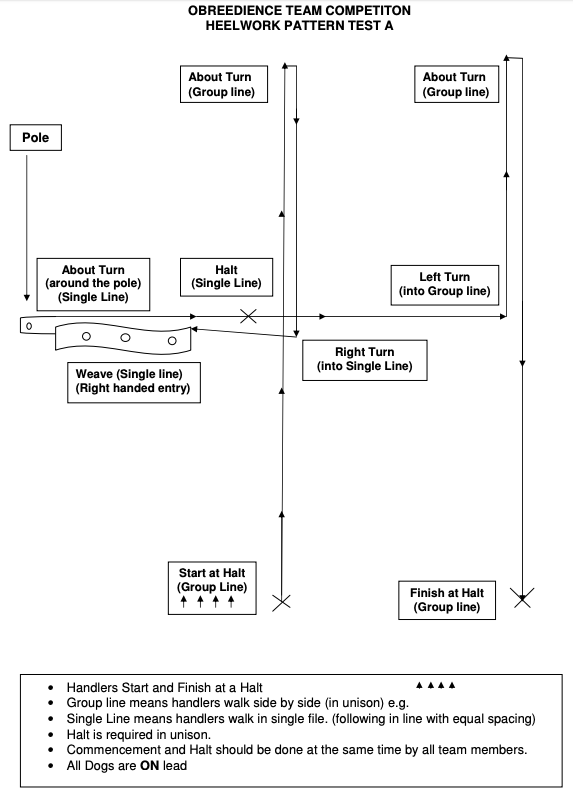
Test B
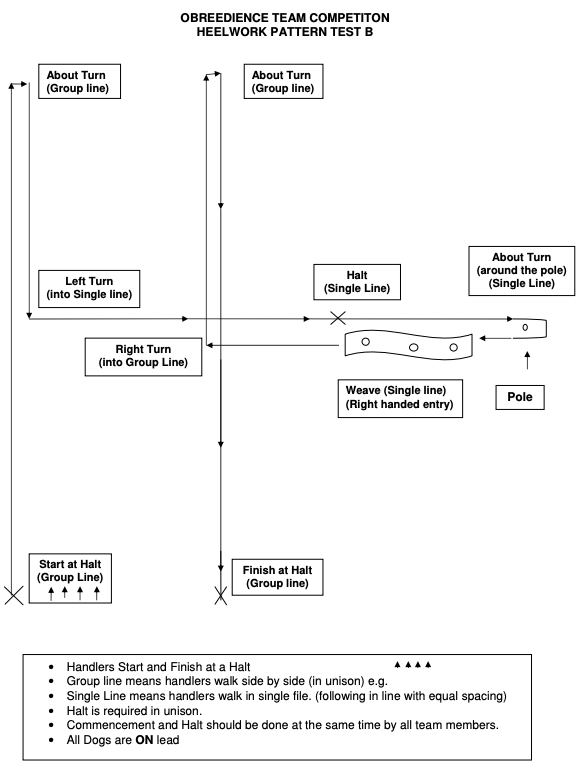
Test C
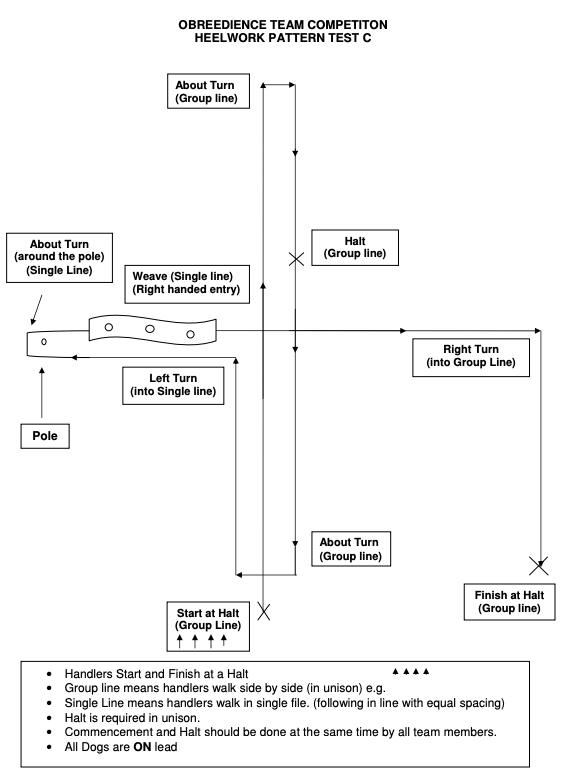
Set exercises
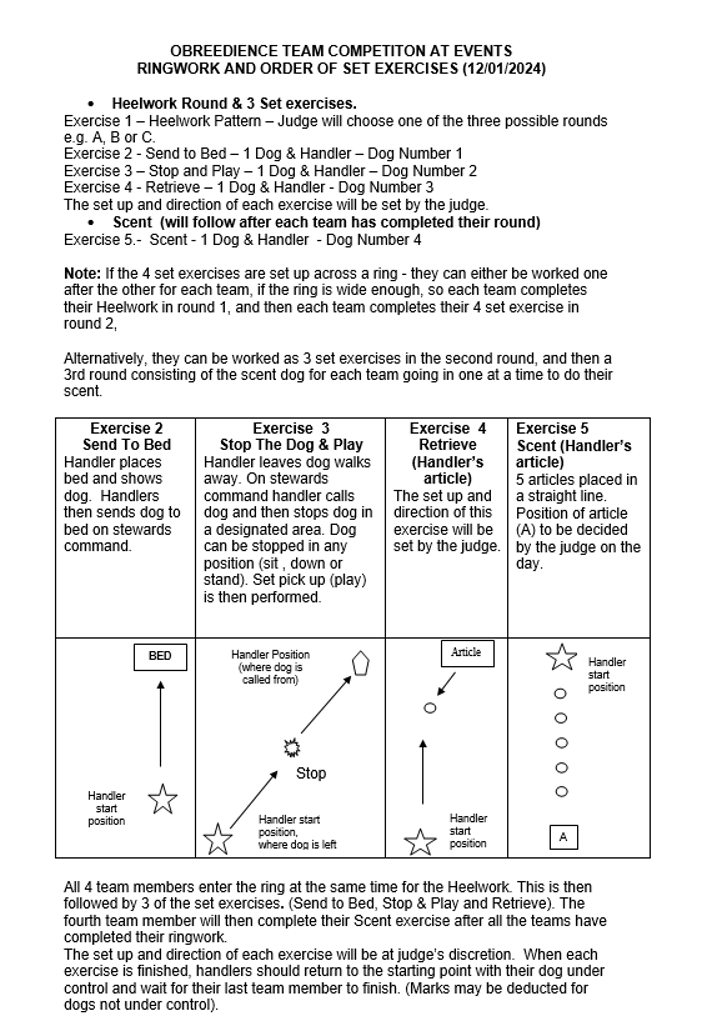

Heats for Crufts 2026
Heats for Crufts 2026
| Club name & Location | Date of the Show | Contact name & Email |
|---|---|---|
| United Spaniel Association. Derby College Equestrian Centre, Broomfield Hall, Morley, Derbyshire DE7 6DN | 19/01/2025 | Mrs Shula Shipton |
| Sheffield GSD Society. Newark Showground, Winthorpe, Newark, NG24 2NY | 13/04/2025 | Anne Hardy |
| Best Paw Forward Rally Obedience Club. Copt Oak Memorial Hall, Copt Oak, Whitwick Road, LE67 9QB | 26/04/2025 | Sabine Kanzaria |
| Nuneaton Dog Training Club. Nuneaton Dog Training Club, Old Hinckley Road, Nuneaton, CV10 0AA | 10/05/2025 | Julia Bodsworth |
| Loughborough Dog Training Club. Coalville Rugby Football Club, Hall Lane Whitwick, Nr Coalville, Leicestershire LE67 5PF | 17/05/2025 | Ruth Lewis |
| Durham County Canine Association. Tanfield Lane Farm, Tanfield, Stanley, Co. Durham, DH9 9BH | 12/07/2025 | Mechelle Jacques |
| Winchester City Dog Training Club. Embley School, Embley Park, Romsey, Hampshire, SO51 6ZE | 13/07/2025 | Sue Adams |
| Culverstone Dog Training Club. Ashford Rugby Club, Kinney’s Lane, Canterbury Road, Ashford TN24 9QB | 20/07/2025 | Joanna Newman |
|
Hatchford Brook DTC, Birmingham and Solihull Rugby Club |
03/08/2025 | Annette Dowd |
| Solihull DTC. Birmingham & Solihull Bees Rugby club, Forshaw Heath Lane, Nr Portway, Birmingham, B94 5 LH | 05/08/2025 | Jennifer Wyatt |
| Worcester Dog Training Club. Ashdown Farm, Badsey, Near Evesham, Worcestershire, WR11 7EL | 24/08/2025 | Louise Williams |
| Best Paw Forward Rally Obedience Club. Copt Oak Memorial Hall, Copt Oak, Whitwick Road, LE67 9QB | 30/08/2025 | Sabine Kanzaria |
| Lichfield & District Dog Training Society. Stafford County Showground, Weston Road, Stafford, ST18 0BD | 13/09/2025 | Carol Hartland |
| Sheffield GSD Society. Newark Showground, Winthorpe, Newark, NG24 2NY | 19/10/2025 | Anne Hardy |
Results from Crufts 2025
Results from Crufts 2025
| Place | Breed Team | TOTAL POINTS |
|---|---|---|
| 1st | THE LABRAPAWS | 47.25 |
| =2nd | MANCHESTER’S REUNITED | 46 |
| =2nd | THE GOLDEN ACORNS | 46 |
| 3rd | COOL COCKERS | 43 |
| 4th | THE SUPERNOVAS | 40.5 |
| 5th | THE RUSSELLERS | 35.75 |
| 6th | SPRING IT ON | 34 |
| 7th | THE WAGTAILS | 33.25 |
| 8th | DASHASTIC | 33 |
| 9th | STAFFORD STARS | 23.75 |
